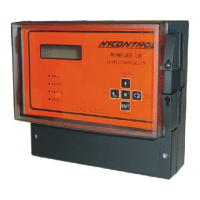SECTION 5
L) Reading on display and outputs stay high:-
* This is usually caused by return echoes from close-in obstructions.
1. Check for obstructions. If the transducer is mounted on a standpipe, check for
rough edges at the connection with the vessel, refer to figure 6 Page 7.
2. If there are no close-in obstructions ensure that the isolation kit is fitted on the
transducer and that the transducer is mounted correctly. The isolation kit
should enable the transducer to move slightly, it should not be solid. (Not
applicable to flanged transducers.)
3. Check the entry at Pr.4.0, Blanking distance, and return it to 0.5m if reduced
from factory setting
4. May be caused by rate of change, Pr.5.0 being too small.
M) Reading is lower than expected:-
1. Check that Pr.2.0 and Pr.3.0 are correct for the application
2. It can be caused when the level rises into the blanking zone. The system can
then lock on to a multiple echo, and may continue tracking the multiple when
the level decreases. Using check search Pr.12.8 should rectify this situation, but
preventing the level entering the blanking zone is the preferred solution.
3. It can also be caused by the level moving at a much faster rate than is allowed
for by the defined rate of change (Pr.5.0). To solve the problem the rate of
change value should be increased to more closely match the real rate.
N) Reading changes in steps:-
* This is usually caused by the rate of change value (Pr.5.0) being too
small to keep up with the process.
1. To rectify, increase the value of Pr.5.0 to match the rate of change of level.
O) The display is inaccurate:-
1. The empty distance (Pr.3.0) of the vessel may be incorrectly set.
2. The dimensions of the vessel or flume may be incorrect, as may the values of
maximum flow, volume or mass conversion.
3. The system may require temperature compensation.
4. The application may include vapours that significantly change the speed of
sound.
Ref: MINIFLEX LR MANUAL Rev. 0 46

